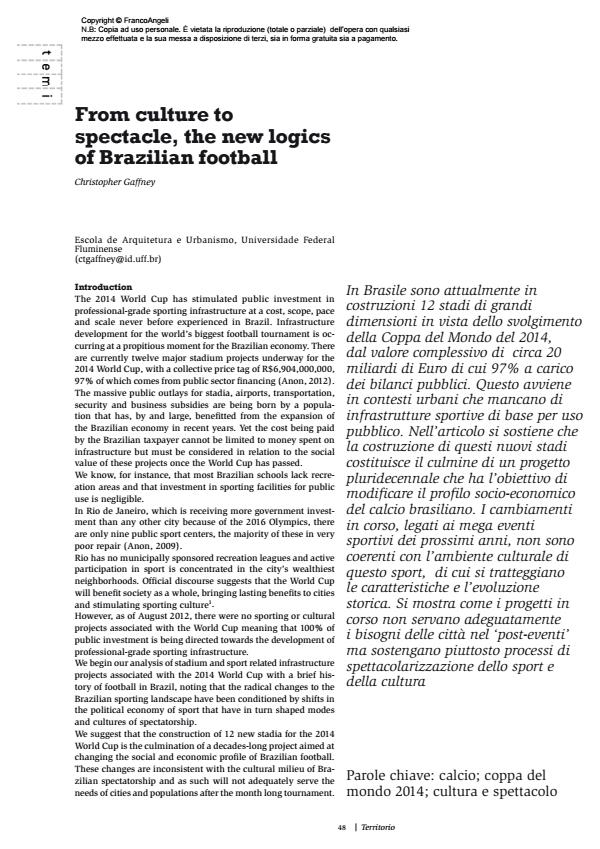From culture to spectacle, the new logics of Brazilian football
Journal title TERRITORIO
Author/s Christopher Gaffney
Publishing Year 2013 Issue 2013/64 Language Italian
Pages 6 P. 48-53 File size 264 KB
DOI 10.3280/TR2013-064008
DOI is like a bar code for intellectual property: to have more infomation
click here
Below, you can see the article first page
If you want to buy this article in PDF format, you can do it, following the instructions to buy download credits

FrancoAngeli is member of Publishers International Linking Association, Inc (PILA), a not-for-profit association which run the CrossRef service enabling links to and from online scholarly content.
Twelve large size stadiums are currently under construction in Brazil to host the 2014 World Cup for a total cost of around Euro 20 billion of which 97% met by public funding. This is taking place in urban contexts that are lacking in basic sports facilities for public use. The paper holds that the construction of these new stadiums constitutes the culmination of a project lasting several decades, the objective of which is to change the socio-economic profile of Brazilian football. The changes in progress relating to the mega sports events to be held in the next few years are not compatible with the cultural environment of this sport; an outline is given of its nature and history. It is shown that the projects underway do not adequately meet the needs of the city after the events, but rather support processes to further commercialise the sport and its culture from a show business viewpoint.
Keywords: Football; 2014 World Cup; culture and show business
- Aidar A.C.K., Leoncini Pereira M., De Oliveira J.J., 2000, A nova gestão do futebol, Fgv Editora, Rio de Janeiro.
- Alabarces P., 2003, Futbologías: fúbol, identidad y violencia en América Latina, Clacso, Buenos Aires.
- Alegi P., 2008, «‘A Nation To Be Reckoned With’: The Politics of World Cup Stadium Construction in Cape Town and Durban, South Africa», African Studies, vol. 67, n. 3, pp. 397-422 (http://dx.doi.org/10.1080/00020180802505038).
- Anon, 2009, Na cidade-sede dos Jogos Olímpicos, 45% das escolas públicas não têm sequer uma quadra de esportes, «O Globo Online», outubro (http://oglobo.globo.com/rio/rio2016/mat/2009/10/10/na-cidade--sede-dos-jogos-olimpicos-45-das-escolas-publicas-nao-tem-sequer--uma-quadra-de-esportes-768006155.asp).
- Anon, 2012, Previsão atual de custo dos estádios da Copa é o triplo da primeira estimativa da CBF (http://copadomundo.uol.com.br/noticias/redacao/2012/05/03/previsao-atual-de-custo-dos-estadios-da-copa-e--tres-vezes-maior-que-a-1-previsao-da-cbf.htm).
- Buarque De Hollanda B.B., 2009, Clube como vontade e representação, o: o jornalismo esportivo e a formaçao das torcidas, 7 Letras, Rio de Janeiro.
- Caldas W., 1990, O Pontapé Inicial: Memória do Futebol Brasileiro (1894-1933), Ibrasa, São Paulo.
- Caldeira T.P.R., 2000. City of Walls: Crime, Segregation, and Citizenship in São Paulo, University of California Press, Berkeley.
- Coutinho F., 2010, Receita Federal multa a CBF em R$ 3 milhões por sonegação de Imposto de Renda, Folha de São Paulo, agosto 29 (www1.folha.uol.com.br/esporte/790573-receita-federal-multa-a-cbf-em-r-3--milhoes-por-sonegacao-de-imposto-de-renda.shtml).
- Durão V.S., 2010, Maracanã ganha cara nova para Copa 2014, «Valor Econômico», março 31 (www.valor.com.br/seminarios/investinrio/suplemento/suplemento16.shtml).
- Gaffney C. 2010, «Mega-events and Socio-spatial Dynamics in Rio de Janeiro, 1919-2016», Journal of Latin American Geography, vol. 9, n. 1, pp. 7-29 (http://muse.jhu.edu/journals/journal_of_latin_american_geography/summary/v009/9.1.gaffney.html).
- Gaffney C., Omena de Melo E.S., 2010, «Mega-eventos esportivos: reestruturação urbana para quem?», Proposta, vol. 121 edição. Gaffney C.T., 2008, Temples of the Earthbound Gods: Stadiums in the Cultural Landscapes of Rio de Janeiro and Buenos Aires, University of Texas Press, Austin (1st ed.).
- Harvey D., 2001, Spaces of Capital: Towards a Critical Geography. Routledge, London.
- Helal R., Soares A.J., Louisolo H., 2001, A Invenção do país do futebol: mídia, raça, e idolotria, Mauaad, Rio de Janeiro.
- Kfouri J., 2010, Sobre a CBF e o Clube dos 13, Blog do Juca Kfouri, março 30 (http://blogdojuca.uol.com.br/2010/03/sobre-a-cbf-e-o-clube-dos-13-3/).
- Maennig W., Du Plessis S., 2007, «World Cup 2010: South African Economic Perspectives and Policy Challenges Informed by the Experience of Germany 2006», Contemporary Economic Policy, vol. 25, n. 4, pp. 578-590 (http://doi.wiley.com/10.1111/j.1465-7287.2007.00074.x).
- Mascarenhas de Jesus G., 2000, «Construindo a Cidade Moderna: A Introduço dos Esportes na Vida Urbana do Rio de Janeiro», Estudos Históricos 23, n. 1, pp. 17-37).
- Mascarenhas de Jesus G., 2002, «Várzeas, Operários e Futebol: Uma outra Geografia», Geografia 4, n. 8, pp. 115-29.
- Mascarenhas de Jesus G., Bienenstein G., Sánchez F., 2011, O jogo continua: megaeventos esportivos e cidades, Eduerj, Rio de Janeiro.
- Matta R., 2006, A bola corre mais que os homens: duas copas, treze crônicas e três ensaios sobre futebol, Rocco, Rio de Janeiro.
- Melo De V.A., 2000, Cidadesportiva: primórdios do esporte no Rio de Janeiro, Relume, Dumará.
- Murad M., 1996, Dos pés à cabeça: elementos básicos de sociologia do futebol, Irradiação Cultural, Rio De Janeiro.
- Pithouse R., 2008, Business as Usual? Housing Rights and ‘Slum Eradication’ in Durban, South Africa, The Centre on Housing Rights and Evictions (Cohre), Geneva (www.cohre.org/news/documents/south-africabusiness-as-usual-housing-rights-and-slum-eradication-in-durban).
- Rebelo A., Torres S., 2001, Cbf Nike, Casa Amarela, Rio de Janeiro.
- Rodrigues C., 2010, «South Africa’s World Cup is a Disgrace», The Guardian, maio 6 (http://www.guardian.co.uk/commentisfree/2010/may/06/south-africa-world-cup-spending-disgrace).
- Rodrigues M. Jr., 1964, O Negro no Futebol Brasileiro, Civilização, Rio de Janeiro.
- Sánchez F., 2010, A reinvenção das cidades para um Mercado global, Argos, Chapeco, Santa Catarina.
- Yallop D.A., 1998, Como eles roubaram o jogo: segredos dos subterrâneos da Fifa, Record, Rio de Janeiro.
- Virando o jogo Christopher Gaffney, in Journal of Sport and Social Issues /2015 pp.155
DOI: 10.1177/0193723513515887 - How mega-events capture their hosts: event seizure and the World Cup 2018 in Russia Martin Müller, in Urban Geography /2017 pp.1113
DOI: 10.1080/02723638.2015.1109951
Christopher Gaffney, From culture to spectacle, the new logics of Brazilian football in "TERRITORIO" 64/2013, pp 48-53, DOI: 10.3280/TR2013-064008